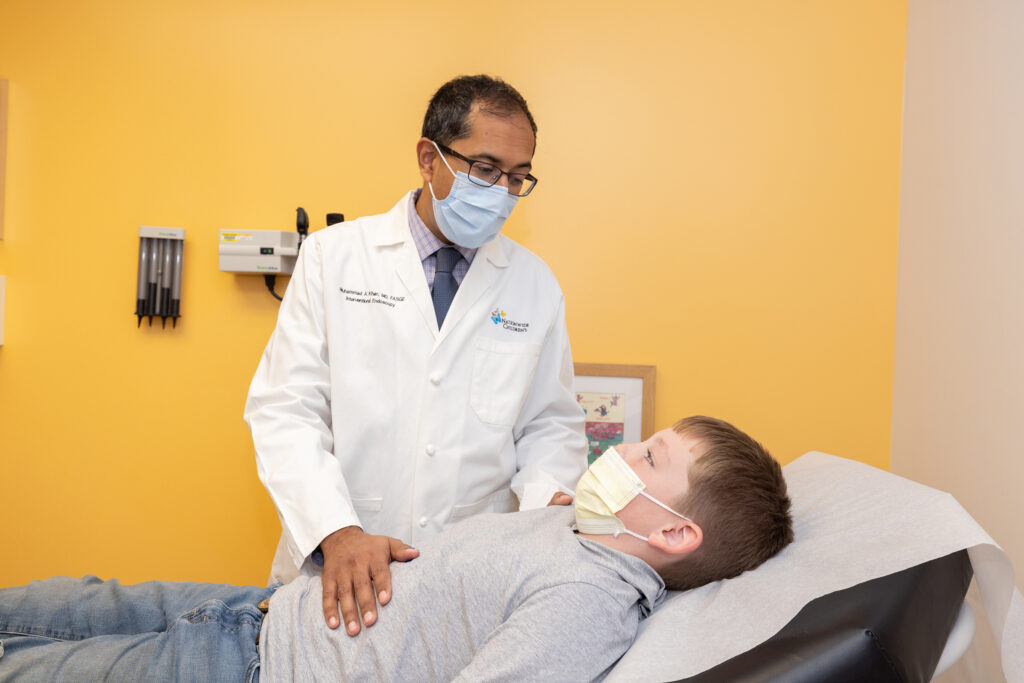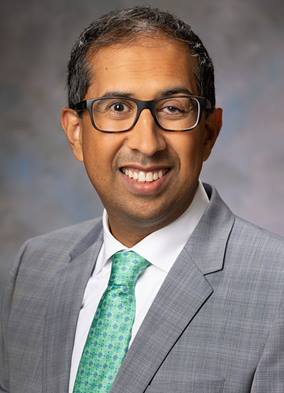Mason’s Story: A Less Invasive Solution for Achalasia
Mason’s Story: A Less Invasive Solution for Achalasia https://pediatricsnationwide.org/wp-content/uploads/2023/02/110422BT067-1024x683.jpg 1024 683 Emily Siebenmorgen Emily Siebenmorgen https://pediatricsnationwide.org/wp-content/uploads/2023/05/Emily.Siebenmorgen-scaled-e1684876333147.jpg- February 14, 2023
- Emily Siebenmorgen

A 9-year-old boy with life-long difficulty eating and keeping down food underwent a new procedure being performed in children from Muhammad Khan, MD, MPH, FASGE, pediatric gastroenterologist and the director of interventional and diagnostic endoscopy at Nationwide Children’s Hospital.
Achalasia is a progressive swallowing disorder, where the muscles at the bottom of the esophagus fail to relax while eating. Food frequently gets stuck in the esophagus until it eventually passes through, stretching and dilating the esophagus in the process. Patients may throw up the food that doesn’t pass through. In addition to being extremely uncomfortable, patients can lose weight and have pain and trouble swallowing.
“Mason’s symptoms were first documented in 2019, but he had them for years,” Mason’s mother Veronica says. “He was a ‘spit up’ baby, and I thought that was totally normal. It wasn’t until he got older and could say what was going on that we realized his symptoms weren’t normal – and they weren’t going away.”
After an esophagogastroduodenoscopy (EGD) examination from a hospital in St. Louis, a specialist told Mason that he would grow out of his symptoms. But according to Mason’s mom, his symptoms didn’t go away, and they continued a diagnostic odyssey looking for answers.
Until they moved to Ohio and got a referral for a swallow study at Nationwide Children’s.
“The radiologist suspected Mason’s achalasia immediately,” Veronica says. “I saw the contrast go down and stop in his esophagus. Getting answers after years of misdiagnosis lifted such a weight off my shoulders.”
Achalasia is uncommon in adults and even less common in children, with a major pediatric hospital seeing just a handful of cases each year. Achalasia tends to present in kids when they are either very young or as teenagers, and is sometimes associated with certain congenital syndromes or infections.

“Achalasia is a lifelong problem, but our goal is to diagnose and intervene early so that patients don’t have long-term problems, like dilation of the esophagus and more swallowing and regurgitation problems,” Dr. Khan says.
Following his swallow study, Mason’s team in the Division of Gastroenterology, Hepatology and Nutrition at Nationwide Children’s performed an esophageal manometry test and EndoFLIP with EGD to confirm the diagnosis. After reviewing several treatment options with Mason and his family, Dr. Khan performed a peroral endoscopic myotomy (POEM) procedure.
There are a few solutions to treating achalasia. On the surgical front, a laparoscopic Heller myotomy (LHM) has been the traditional – and until recently, only – approach. It requires making up to five small incisions in the abdomen to insert surgical instruments, followed by an incision into the muscle tissue of the esophagus and stomach to relieve pressure on the lower esophageal sphincter. Now, the POEM procedure provides a less invasive solution.
“The POEM procedure is a relatively new endoscopic technique that doesn’t require cutting a hole through multiple layers of esophageal tissue at the same site,” Dr. Khan says. “For a POEM, the endoscopist will make a small entry through the inner mucosal lining of the esophagus, create a submucosal tunnel in the third space between tissue walls, and cut through the outer muscle layer to perform the myotomy. The mucosal entry site is then closed with a few small clips placed endoscopically, which fall off after a few weeks when the site is healed.”
Compared to a laparoscopic Heller myotomy, Dr. Khan explains the POEM procedure is a safer and less invasive alternative.
“Patients do very well after POEM, with 92 to 96% success rates and less than 3% complication rate in children,” Dr. Khan says. “Also, compared to Heller Myotomy patients who may stay in the hospital for a week following a procedure, patients typically stay overnight after POEM before going home.”
While a POEM procedure may seem like an obvious choice for achalasia treatments, finding experts who can perform a POEM for patients like Mason is a limited search.
“There are probably around 200 endoscopists who can do a POEM procedure on adults, but far fewer that do this procedure in kids,” Dr. Khan says. “I did extra training in interventional endoscopy that includes some of these surgical endoscopy skills, including POEM, endoscopic ultrasound, pancreaticobiliary endoscopy, and complex polyp resections. For now, I’m the only one who does all of these procedures in pediatric patients, but I’m trying to get other people build up their skills so we can treat more children using less invasive strategies.”
Veronica says this procedure was life-changing for Mason.
“I was hesitant to believe that the procedure would work because of how long of a journey it had been to get to this point,” she says. “But Mason’s procedure took one hour and everything was great. I was a whole basket of tears after seeing the fluid travel all the way down to his stomach during his follow-up swallow study the next morning.”
Dr. Khan emphasizes that Nationwide Children’s can offer patients their preferred treatment option – from balloon dilation to a POEM procedure – and will work with their team to be partners in the patient’s care.
“I want regional gastroenterologists to be able to turn to our renowned motility team to diagnose these patents and talk about treatment options,” Dr. Khan says. “On a national level, I want people to think about POEM as a preferred treatment, and they should find skilled people who can do this around the country.”
About the author
Emily Siebenmorgen is a Science Communication Specialist at Nationwide Children's Hospital with a passion for making research findings accessible. From her time writing at Battelle and AWRI's Center for Injury Research and Policy, she has experience distilling complex topics into simple takeaways for both professional and consumer audiences. Emily earned her BS in Psychology and BA in Strategic Communication from The Ohio State University.
-
Emily Siebenmorgenhttps://pediatricsnationwide.org/author/emily-siebenmorgen/
-
Emily Siebenmorgenhttps://pediatricsnationwide.org/author/emily-siebenmorgen/
-
Emily Siebenmorgenhttps://pediatricsnationwide.org/author/emily-siebenmorgen/September 29, 2022
-
Emily Siebenmorgenhttps://pediatricsnationwide.org/author/emily-siebenmorgen/October 17, 2022
- Posted In:
- Patient Story








